|


|
 Cultural site  Natural site  Mixed site  Africa 
 |
 Kenya, WHV01 Kenya, WHV01Fort Jesus, Mombasa
Date: 08/05 ~ 08/26
The Fort, built by the Portuguese in 1593-1596 to the designs of Giovanni Battista Cairati to protect the port of Mombasa, is one of the most outstanding and well preserved examples of 16th Portuguese military fortification and a landmark in the history of this type of construction. The Fort's layout and form reflected the Renaissance ideal that perfect proportions and geometric harmony are to be found in the human body.
Work : Making news letters for the heritage sites
Volunteers will facilitate educational activities with young children in the host community to promote culture.
Sensitize the international and local volunteers the local community as well as the concerned authorities around issues related to world Heritage.
Location : Mombasa county coast province
Accommodation : In School dormitory
|
 |
 Kenya, WHV02 Kenya, WHV02Sacred Mijikenda Kaya Forests
Date: 07/06 ~ 07/27
The Mijikenda Kaya Forests consist of 11 separate forest sites spread over some 200 km along the coast containing the remains of numerous fortified villages (known as kayas) of the Mijikenda people. The kayas created as of the 16th century but abandoned by the 1940s are now regarded as the abodes of ancestors and are revered as sacred sites and are maintained as by councils of elders. The site is inscribed as bearing unique testimony to a cultural tradition and for its direct link to a living tradition.
Work : Volunteers will be involved in potting for planting trees, naming trees, teaching and landscaping at the nearby school, creating awareness on the conservation efforts and prepare tree nurseries. There will also be extra curriculum activities carried out together with the local community as well as home visits. Volunteers will work for six hours per day from Monday to Friday.
Location : Kinondo, Kwale County
Orientation will be held on 6th July 2013 at the local office in Kilimani, Narobi
Accommodation :
Project hosts will provide accommodation with two separate rooms for male and female volunteers. This will be very modest and designed in a work camp set-up where there are no beds, electricity and running water (in most cases) and the volunteers will sleep on the floor using mats and sleeping bags to experience the complexities of life in rural Kenya. Volunteers with special needs like those who are physically challenged should alert KVDA on application so that efforts are made to accommodate them appropriately.
|
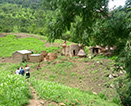 |
 Togo, WHV03 Togo, WHV03Koutammakou, the Land of the Batammariba
Date: 07/08 ~ 07/26
The Koutammakou landscape in north-eastern Togo, which extends into neighboring Benin, is home to the Batammariba whose remarkable mud tower-houses (Takienta) have come to be seen as a symbol of Togo. The 50,000-ha cultural landscape is remarkable due to the architecture of its tower-houses which are a reflection of social structure; its farmland and forest; and the associations between people and landscape.
Work:
• Prepare and maintain paths leading to the site,
• Examine and study the possibility of creating tourist circuits to
visit the site,
• Examine and study the possibility of installing tourist infrastructures
on the site,
• Sensibilisation campaigns,
• Re-afforestation project based on the plant varieties
in the Koutoumakou region,
• Construction of a Tata to serve as a place to lodge tourists,
• Debates, studies and reflections on the questions posed by
the World Patrimony Project of UNESCO.
Location : Nadoba, Togo, West Africa
|
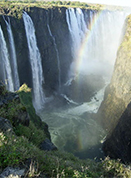 |
 Zimbabwe, WHV04 Zimbabwe, WHV04Victoria Falls
Date: 07/18 ~ 08/05
The Victoria Falls Reserve Preservation Ordinance of 1934 established the Victoria Falls Executive Committee to be responsible for the preservation of the falls area. In 1948 the National Monuments Commission established a Victoria Falls Conservancy Committee, and extended the protected area downstream to Songwe Gorge (confirmed in legislation in 1949). In 1953 the colonial Governor formed the Victoria Falls Trust, which had responsibility for the area until the national park was declared on 25 February 1972 by Statutory Instrument No. 44 (when the area came under the jurisdiction of the National Parks and Wildlife Service). There are six national monuments within the park, including the falls. Designated as a World Heritage site in 1989.
Work: Volunteers will work with the community as well as local participants on restoring the UNSECO World Heritage Site
Location : South western part of the country, 16km outside Bulawayo.
Terminal : Joshua Nkomo International Airport
|
 |
 Uganda, WHV05 Uganda, WHV05Tombs of Buganda Kings at Kasubi
Date: 08/03 ~ 08/24
The Tombs of Buganda Kings at Kasubi constitute a site embracing almost 30 ha of hillside within Kampala district. Most of the site is agricultural, farmed by traditional methods. At its core on the hilltop is the former palace of the Kabakas of Buganda, built in 1882 and converted into the royal burial ground in 1884. Four royal tombs now lie within the Muzibu Azaala Mpanga, the main building, which is circular and surmounted by a dome. It is a major example of an architectural achievement in organic materials, principally wood, thatch, reed, wattle and daub. The site's main significance lies, however, in its intangible values of belief, spirituality, continuity and identity.
Work: The volunteers will organize activities such as tree planting, production of awareness and advocacy materials, screening of cultural films, etc. Furthermore, volunteers will run awareness raising workshop involving communities and conduct debates, reflections and exchanges on World Heritage issues as
Activity :
- Preservation,protection,planting trees,cleaning,education
- campaign,sensitization,advocacy,promotion,documentary production
|
 |
 Zambia, WHV06 Zambia, WHV06Mosi-oa-Tunya / Victoria Falls
Date: 07/28 ~ 08/11
This camp was hosted for the first time in 2009 to celebrate the 20th year of the Victoria falls being inscribed on the World Heritage Site list. Since then an annual camp dedicated to realizing and appreciating the outstanding universal value of the Victoria Falls has been hosted in partnership with the local community, the National Heritage Conservation Commission, UNESCO's World Heritage Centre in Paris and the World Heritage Volunteers program.
Study theme: the theme of this camp is 'heritage and tourism' because this camp will be hosted almost at the same time at the United Nations World Tourism Organization's Conference hosted by Zambia and Zimbabwe.
Study theme : the theme of this camp is 'heritage and tourism' because this camp will be hosted almost at the same time at the United Nations World Tourism Organization's Conference hosted by Zambia and Zimbabwe.
Location : Livingstone, Southern Province
Accommodation : volunteers will be accommodated at the project site.
|
 Latin America 
 |
 Mexico, WHV07 Mexico, WHV07Historic Centre of Morelia
Date: 07/10 ~ 07/26
This will be the 7th year this project is organized in Morelia City; the aim of this project is to maintain the historic Morelia's downtown declared world's heritage by UNESCO to preserve all its splendor and beauty. Morelia is a beautiful colonial city built in "pink stone" it has a really nice weather, volunteers in past projects helped in different restoration activities and workshops to create awareness about the importance to preserve the World Cultural Heritage. The local host will be happy to have a new group because of the very good memories of past volunteers and the very good results of this project. People in Morelia is very friendly, so if you are looking for a project in a very nice city with a lot of culture and history and to do something useful and make new friends, this project is for you!
Work : Together with groups of local volunteers, the international volunteers will realize different activities to restore historical buildings, paint specific parts of the downtown as well as maintenance tasks such as restoration of ancient fountains. The local volunteers are looking forward to welcome the international volunteers to make a meaningful work but also make friends and show the Mexican culture!LEISURE
Location: Morelia city is located in the center of Mexico, it is very well connected by bus and it's located very close to big cities such as Mexico City (3 hours), Guadalajara city (3.5 hours), Guanajuato City (2 hours).
Accommodation : Volunteers will be hosted in a private house with all facilities at disposal: kitchen, hot water, etc. the food and accommodation will be provided by the host project but volunteers will be responsible to cook and clean the place (please bring snacks and typical recipes from your country to share with the other volunteers!). It is possible to cook vegetarian food (in case you don't eat meat).
|
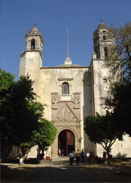 |
 Mexico, WHV08 Mexico, WHV08 Earliest 16th-Century Monasteries on the Slopes of Popocatepetl (Atlatlahucan)
Date: 08/10 ~ 08/24
The historical monuments of Atlatlahucan as fundamental attraction is the former convent of the Augustinian order, a marvelous temple built in the sixteenth century. Because the majesty of the Convent of St. Matthew the Apostle, the details of its architecture which, although not complicated, but simple style continues to be a major attraction for visitors. His height allows it to be observed from the surrounding communities, give presence to the path of those whose in their journey have the opportunity to be close to this precious architectural jewel of the sixteenth century and today is part of the World Heritage, as it was declared as such in the year 1994 by UNESCO. This former convent is part of the Convent Route, which recently was awarded the Best International Touristic Product Award at the International Tourism Fair in Spain.
Work : The volunteers will some secondary works in the building and some cleaning and renovation work guided by a professional restorer. These will be complemented by awareness-raising activities that volunteers carry our with the local population, particularly with the children and youth of the village: workshops on the identification of heritage assets, tours of heritage sites in the town, presenting some heritage sites of their countries and regions to high school students, secondary and primary school, animations with the kids, cleaning campaign around the village and systematization of the experience.
Location : Atlatlahucan is located 20 km from Cuautla in the region of Morelos
Accommodation :
In a house in the village
|
 |
 Mexico, WHV09 Mexico, WHV09Churches in the Zoque Province, Chiapas
Date: 07/20 ~ 08/03
Project: This valuable historic complex includes eight XVI-century churches built under the guidance of Dominican friars, whose goal was to evangelise the Zoque people, a culture which was still very much alive, and was heir to one of the most ancient cultures in Mesoamerica. The building project was originally of European design, but it soon acquired local features, and it is therefore one of a kind in Mexican Colonial art. The presence of these churches triggered the development of a school of gilded and painted sculpture.
Since 2009, Natate has been organizing Patrimonito -World Heritage Volunteers (WHV) workcamps in the Churches in the Zoque Province, in a joint effort to support its possible inscription to the official World
Heritage List.
Work : During The international volunteers will work in basic restoration activities supervised by professionals of INAH. They will also organize intercultural workshops with local students creating promotional and educational materials for informative campaigns- and design activities strictly related with site management and sustainable development which will involve the local population, as well as national, State and local agencies. The international volunteers will participate in the tasks of maintenance and preservation of the church, organizing "heritage focused" workshops for the kids and youth of the Zoque province, support cleaning of the main site, and organizing different WH raising awareness and environmental activities. Volunteers will also take classes of Zoque language, learn traditional pre-Hispanic and Mexican folk dances, learn how to play local musical instruments, and co-organize a Cultural Zoque Festival together with the local community. These actions will implement the preservation of the churches, which are an important gathering site for the Zoque descendant population, and key site for the rescue of the Zoque language.
Volunteers and local youth will also create a video and a photographic diary - a visual memory - of the site, works and activities done during the workcamp. Volunteers will publish these in a website, creating visibility also through social networks. Videos and pictures will be also broadcasted and published by local media, to raise awareness among the population of the State of Chiapas regarding World Heritage and the importance of preserving this significant site. This action will eventually support the development of the
cultural touristic potential of Chapultenango, Tapaplapa and CopainalA. Accommodation: Volunteers will stay at house owned by the community and will have all the basic services. Be prepared for hand washing your own clothes.
Location : Chapultenango, Copainala and Tapalapa are towns.
Accommodation :Volunteers will stay at house owned by the community and will have all the basic services. Be prepared for hand washing your own clothes. Try to be environmentally friendly as possible and use resources with care and modesty, especially because your behaviour is part of the project ;)
|
 Asia 

|
 China, WHV10 China, WHV10The Great Wall
Date: 07/07 ~ 07/20
In c. 220 B.C., under Qin Shi Huang, sections of earlier fortifications were joined together to form a united defence system against invasions from the north. Construction continued up to the Ming dynasty (1368-1644), when the Great Wall became the world's largest military structure. The Great Wall runs across North China like a huge dragon. It winds its way from west to east, across deserts, over mountains, through valleys till at last it reaches the sea. It's the longest wall on the earth, also one of the wonders in the world. Its historic and strategic importance is matched only by its architectural significance.
Work : The practical part (July 8th - 13th): The volunteers will enlighten teenagers about the history and significance of the Great Wall and do some practical work in site. The tasks at the World Heritage place will vary, for exemple volunteers will discover the present problems of the safety of tourists at the Great Wall. They will also help to improve the tourist guides and signs around the WH site. If the weather conditions allow to do so, volunteers will plant some trees in the surrounding areas and do some cleaning work. Volunteers will interview local tourists and do many other activities in order to help the site managers to improve the site work and condition, as well as to raise the awareness among local visitors and people living around the site area about the importance to protect our World heritage.
The school education part (15th July - 20th July): Volunteers will work together with Chinese volunteers to present to middle school. There will be three TOPICS each day for five days. They are the "World Heritage Basics", "The safety of tourists at Great Wall" and "World Heritage outside China".
Location : The school located in Xidan district,Beijing
Accommodation :Two persons live in one room with a separate bathroom and a lavatory in the school (the school will prepare a set of bedding for you) or in the hotel near the Great Wall. Clothes must be hand washed in a basin provided by the school. The school located in Xidan district, Beijing.
|
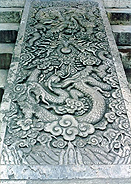
|
 China, WHV11 China, WHV11Temple and Cemetery of Confucius and the Kong Family Mansion in Qufu
Date: 07/22 ~ 08/08
The temple, cemetery and family mansion of Confucius, the great philosopher, politician and educator of the 6th-5th centuries B.C., are located at Qufu, in Shandong Province. Built to commemorate him in 478 B.C., the temple has been destroyed and reconstructed over the centuries; today it comprises more than 100 buildings. The cemetery contains Confucius' tomb and the remains of more than 100,000 of his descendants. The small house of the Kong family developed into a gigantic aristocratic residence, of which 152 buildings remain. The Qufu complex of monuments has retained its outstanding artistic and historic character due to the devotion of successive Chinese emperors over more than 2,000 years.
Work : The practical part(July 23rd-26th): The volunteers will enlighten teenagers about the history and significance of the Temple of Confucius and the Mansion of the Kong family and do some practical work in site. They will communicate with Chinese teenagers on the topic of World Heritage protection, organize performances among other activities on the site. The tasks at the World Heritage places will vary, for example volunteers will discover the present problems of the safety of tourists at the Temple of Confucius. They will also help to improve the tourist guides and signs around the WH site. If the weather conditions allow to do so, volunteers will plant some trees in the surrounding areas and do some cleaning work. Volunteers will interview local tourists and do many other activities in order to help the site managers to improve the site work and condition, as well as to raise the awareness among local visitors and people living around the site area about the importance to protect our World heritage.
The school education part (29th July- 8th August): Volunteers will work together with Chinese volunteers to present to middle school. There will be three TOPICS each day for five days. They are the" World Heritage Basics", "The safety of tourists at Temple of Confucius" and "World Heritage outside China".
Location : The school located in Qufu, Shandong Province.
Accommodation : Two or four persons live in one students' dormitory with air-conditioner which is rather simple and crude. The school will prepare a set of bedding for you. The shower room is in another building beside the living building .Clothes must be hand washed in a basin provided by the school
|

|
 China, WHV12 China, WHV12Mount Sanqingshan National Park
Date: 07/21 ~ 08/08
Mount Sanqingshan National Park, a 22,950 ha property located in the west of the Huaiyu mountain range in the northeast of Jiangxi Province (in the east of central China) has been inscribed for its exceptional scenic quality, marked by the concentration of fantastically shaped pillars and peaks: 48 granite peaks and 89 granite pillars, many of which resemble human or animal silhouettes. The natural beauty of the 1,817 metre high Mount Huaiyu is further enhanced by the juxtaposition of granite features with the vegetation and particular meteorological conditions which make for an ever-changing and arresting landscape with bright halos on clouds and white rainbows. The area is subject to a combination of subtropical monsoonal and maritime influences and forms an island of temperate forest above the surrounding subtropical landscape. It also features forests and numerous waterfalls, some of them 60 metres in height, lakes and springs.
Work : The practical part (July 23rd -26th ): The volunteers will enlighten teenagers about the history and significance of the Mount Sanqingshan and do some practical work in site. The volunteers will enlighten teenagers about the history and significance of the Mount Sanqingshan and do some practical work in site. The tasks at the World Heritage places will vary, for example volunteers will discover the present problems of the safety of tourists at the Mount Sanqingshan. They will also help to improve the tourist guides and signs around the WH site. If the weather conditions allow to do so, volunteers will plant some trees in the surrounding areas and do some cleaning work. Volunteers will interview local tourists and do many other activities in order to help the site managers to improve the site work and condition, as well as to raise the awareness among local visitors and people living around the site area about the importance to protect our World heritage.
The school education part(29th July- 8th August): Volunteers will work together with Chinese volunteers to present to middle school. There will be three TOPICS each day for five days. They are the" World Heritage Basics", "The safety of tourists at Mount Sanqingshan" and "World Heritage outside China".
Location : The school located in Jiangxi Province. Accommodation : Two persons live in one room with a separate bathroom and a lavatory in the school (the school will prepare a set of bedding for you) or in the hotel near Mount Sanqingshan. Clothes must be hand washed in a basin provided by the school.
|

|
 India, WHV13 India, WHV13 Group of Monuments at Pattadakal
Date: 07/15 ~ 07/28
Historically Badami or Vatapi was the centre of ancient Chalukyan glory. Badami today is a sleepy little town on a red sandstone ridge. The Chalukyas are credited with some of the best traditions of Dravidian architecture including an experimental blend of older South Indian temple architecture and the Nagara style of north India. It was home to several rock-cut temples. Badami's Archeological interest lies in a series of cave temples of 6th century AD excavated for both Hindu and Jain deities.
Work : Project in Badami will concentrate on the protection of the cultural heritage and the sites of historical importance and on creating awareness among the locals, school children, tour-guides and tourists. The volunteers will be involved in cleaning the heritage surroundings, planting trees, thereby converting dry areas into beautiful spots for an eye to rest on. The work will include some physical work and will require a lot of creativity and motivation from the volunteers to convey the message through dramas, street plays and other creative arts. Volunteers will also conduct activities with children to promote awareness about Environment, Health and Hygiene, Heritage conservation through creative learning methods like games, art, songs, dance, music etc.
Location : Badami is located at a distance of about 500 kilometres from Bangalore, Karnataka. It is famous for rock cut and other structural temples. It is located in a ravine at the foot of a rugged, red sandstone outcrop that surrounds Agastya lake. The nearest airport to Badami is Belgaum, which is about 190 kilometres away. Belgaum is connected to Mumbai by domestic flights. Bangalore is the nearest international airport. The exact Meeting Point will be mentioned in the info sheets.
Accommodation : In a rented Guest house or Hostel, with shared rooms.
|

|
 India, WHV14 India, WHV14Group of Monuments at Hampi
Date: 08/12 ~ 08/25
Located in the central part of the state of Karnataka, in the southern part of India, Hampi is definitely one of the most interesting travel destinations on the map of India. It is famous for its ruins belonging to the erstwhile medieval Hindu kingdom of Vijaynagar, now declared a UNESCO World Heritage site. The temples of Hampi, its monolithic sculptures and monuments are breath-taking. The Hindu style of architecture found at Hampi speaks of the splendour of the Vijaynagar Empire.
Work : Project in Hampi will primarily concentrate on protection of the cultural heritage and the sites of historical importance and on creating awareness among the locals, school children, tour guides and the tourists. The volunteers will be involved in cleaning the heritage surroundings, planting trees, thereby converting dry areas into beautiful spots for an eye to rest on. The work will include some physical work and will require a lot of creativity and motivation from the volunteers to convey the message through dramas, plays, puppet shows and other creative arts.
Location : Hampi is located in the state of Karnataka, 350 kilometres from Bangalore, and 13 kilometres from Hospet. Hampi is accessible by bus from Bangalore and Goa. The nearest railway station is in Hospet which is about 13 kilometres away from Hampi. The nearest international airports are Goa, Bangalore and Mumbai. The exact meeting point will be mentioned in the info sheets.
Accommodation : In a rented Guest house or Hostel, with shared rooms.
|
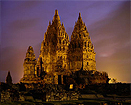
|
 Indonesia, WHV15 Indonesia, WHV15Prambanan Temple Compounds
Date: 08/24 ~ 09/06
Built in the 10th century, this is the largest temple compound dedicated to Shiva in Indonesia. Rising above the centre of the last of these concentric squares are three temples decorated with reliefs illustrating the epic of the Ramayana, dedicated to the three great Hindu divinities (Shiva, Vishnu and Brahma) and three temples dedicated to the animals who serve them.
Work : Volunteers will have restoration work. Besides, before the restoration work, the volunteers will have 1 day orientation about how to do the restoration and given information about the history of the temple, so that the volunteers really gained a lot of knowledge about the temples and the process of restoration. As the volunteers lived in the local community of Kemudo village, they also had activities in the local school with the local students. They will promote to the students how to preserve the temples and do some activities like students competition, culture exchange etc. The volunteers will also campaign about world heritage preservation to the local community as well as the visitors related to the world heritage especially Prambanan Temple.
Location : Kemudo Village is located in Klaten regency, 25 km east of Yogyakarta City and 95 km south east of Semarang.
Accommodation :
The volunteers will be accommodated in local host families (basic conditions, sleeping bag and mat needed), where they will also receive food.
|

|
 Indonesia, WHV16 Indonesia, WHV16 Borobudur Temple Compounds
Date: 08/27 ~ 09/09
This famous Buddhist temple, dating from the 8th and 9th centuries, is located in central Java. It was built in three tiers: a pyramidal base with five concentric square terraces, the trunk of a cone with three circular platforms and, at the top, a monumental stupa. The walls and balustrades are decorated with fine low reliefs, covering a total surface area of 2,500 m2. Around the circular platforms are 72 openwork stupas, each containing a statue of the Buddha. The monument was restored with UNESCO's help in the 1970s.
Borobudur Patrimonito International Work camp focuses on the education and awareness campaigns by involving local senior high school students trained as "Young Guardian", local youth and local people. The target group of the project is visitors of the temple (both domestic and international visitors). The first Borobudur patrimonito work camp in 2009 was able to create a group of 31 Senior High school students under the name of "Young Guardian Borobudur", create educational material for world heritage education highlighting the active involvement of youth and local community if preserving, promoting and protecting the world heritage site in 6 different languages, organize 6 days awareness campaigns entitled " Young Guardian in Action: Together we care" with visitors of Borobudur temple as target group. Beside giving education for the youth to take active involvement in the preservation, promotion and protection effort, the camp was also giving change for them to experience the difficulties of preservation, promotion and protection efforts and implement directly the strategies planned in managing the visitors and increasing their awareness on the importance of their role in determining the future of the temple.
This year Borobudur patrimonito work camp is designed as one of the follow up activities for last year project. The camp will be divided into 3 main activities; Preparation of workshop and training for the second batch "Young Guardian", Training for the Young Guardian, and the awareness campaigns by organizing One stop service desk for visitors of the temple.
Work : Workshop/training for young guardian, campaign at the Borobudur temple area and school visit
Location : Borobudur Village, Mungkid, Magelang, Central Java Indonesia.
Accommodation : family, sleeping bag and mattress needed, self cooking
|
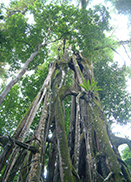
|
 Indonesia, WHV17 Indonesia, WHV17Ujung Kulon National Park
Date: 08/27 ~ 09/09
This national park, located in the extreme south-western tip of Java on the Sunda shelf, includes the Ujung Kulon peninsula and several offshore islands and encompasses the natural reserve of Krakatoa. In addition to its natural beauty and geological interest - particularly for the study of inland volcanoes - it contains the largest remaining area of lowland rainforests in the Java plain. Several species of endangered plants and animals can be found there, the Javan rhinoceros being the most seriously under threat.
Work : The first project in this site is to start up the Young Guardian Club (YGC) in areas around the Ujung Kulon National Park. This is a strategic issue in Ujung Kulon, to involve local youth to protect Ujung Kulon as for many years forest products have become one of the main incomes for the local people and threatening its food chain which leads to threaten its biodiversity and in the end will deprive the existence of the Javanese Rhinoceros as this is their only habitat. Volunteers will join the workshop/training for 1st young guardian, promote Young Guardian Club 2013 to local schools and community, make campaign at the Ujung Kulon area and visit school.
Location : Pandeglang Region, Banten Province
Accommodation : Host family, sleeping bag and mattress needed, self cooking
|

|
 Korea, WHV18 Korea, WHV18Historic Villages of Korea: Hahoe and Yangdong
Date: 08/05 ~ 08/16
Founded in the 14th-15th centuries, Hahoe and Yangdong are seen as the two most representative historic clan villages in the Republic of Korea. Their layout and location - sheltered by forested mountains and facing out onto a river and open agricultural fields - reflect the distinctive aristocratic Confucian culture of the early part of the Joseon Dynasty (1392-1910). The villages were located to provide both physical and spiritual nourishment from their surrounding landscapes. They include residences of the head families, together with substantial timber framed houses of other clan members, also pavilions, study halls, Confucian academies for learning, and clusters of one story mud-walled, thatched-roofed houses, formerly for commoners. The landscapes of mountains, trees and water around the village, framed in views from pavilions and retreats, were celebrated for their beauty by 17th and 18th century poets.
Work : Participants will prepare and organize World heritage awareness educational programs base on non-formal education for visitors and local children. They will also run FACEBOOK for village so that they will promote the village and World heritage for the right understanding through the online events.
Accommodation : The community center in town / Self-catering within a group
|
 Europe
 |
 Armenia, WHV19 Armenia, WHV19Cathedral and Churches of Echmiatsin and the Archaeological Site of Zvartnots
Date: 07/09 ~ 07/22
Zvartnots was built in the middle of the 7th century. This architectural masterpiece is a monument which embodies the centuries-long traditions of Armenian architecture. Unfortunately, like the majority of ancient Armenian temples, Zvartnots has "survived" only in ruins as it was completely destroyed by powerful earthquake in the 10th century. However, even the ruins of this temple give us the idea of its rare and majestic beauty.
Work : The major objective of the workcamp is the preservation of this Historical site for the future generations, to keep it in worthy conditions to allow the visitors to be spiritually enriched and to contemplate the beauty and the splendour of this monument. To support the staff of the Museum of the Zvartnots Cathedral in matters of maintaining the territory and fulfilling different types of work necessary on the particular moment.
Activities for the volunteers:
• Maintenance of the territory - removing the over-grown grass, weeds.
• Helping the stuff in renovating and painting work.
• "National sounds at Zvartnots" - learning Armenian national dances, songs.
• Cultural program - "My impressions about Patrimonito 2012" Power point presentations of the volunteers on their impressions and feelings about the project and plans for the future.
• Implementation of the countries they are from, and the World Heritage Objects existing there
Location : Zvartnots Cathedral
(Address: ZVARTNOTS Cathedral (20 km from capital Yerevan), Armavir Province (Marz))
Accommodation :
Guest house on the territory of the Cathedral
|
 |
 Austria, WHV20 Austria, WHV20Wachau Cultural Landscape
Date: 07/14 ~ 07/27
As one of the oldest cultural landscapes in Austria, the Wachau was declared as a protected zone in 1955, and in the year 1994, attained the European Diploma in Nature Protection. In December 2000, it was nominated to the status of a UNESCO World Heritage site. The Wachau is located in Lower Austria and contains the most valuable and endangered natural habitats in the river valley of the Danube. The river landscape surrounded by hills with small historical villages set in between makes it unique. On the slopes are sunny wine terraces and old orchards, both maintained through hard work.
Work : Natura 2000 is an ecological network of protected areas in the territory of the European Union. The Wachau-Jauerling area is one of them. Many old meadows and abandoned stone terraces rich in biodiversity are in danger. The numbers of livestock send out by farmers has declined, furthermore the mowing activities
declined and as a result, bushes, scrubs and trees are claiming back the grasslands and are overgrowing the stone terraces. Moreover invasive species such as locust (robinia pseudoacacia) and others spread more and more, push back native plants and endanger the floodplains and their typical structure around the Danube.
Together with the farmers of the vineyards and local volunteers we will revitalize important ecological areas by cutting the grass, bushes and trees. In the floodplains along the river we will get rid of invasive species. For two weeks we will be in direct contact with the typical nature in this region and its people.
This camp is one of six over the next three years, which contributes to the Natura- 2000 region with the goal of restoring and conserving 20 hectare of habitat. All together about 300 volunteers will participate in this great attempt to maintain the typical nature of the Wachau. As a side effect we want to demonstrate to
politicians and local communities that there are young people, who don't fear hard work, who care about nature and willing to help out in their free time and who are interested in the conservation of areas worthy of protection.
Accommodation : For both weeks we will stay in the Regionalhautpschule Spitz located in the heart of Wachau. You need a sleeping bag and a camping bag (Isomatte). The kitchens is "ours so we will cook together and we will share international food culture and cooking style."
|
 |
 France, WHV21 France, WHV21The Causses and the Cevennes, Mediterranean agro-pastoral Cultural Landscape
Date: 07/07 ~ 07/27
L'Espinas is a small hamlet situated in Cévennes's mountains, at the heart of the Cevennes National park. It is crossed by the road of the crests which is a big way of transhumance in the direction of the Mont Lozère. The municipality of St Andéol de Clerguemort acquired the hamlet, then abandoned and in ruin, fifteen years ago. Their main objective is to recreate a place of life and exchanges. Several associations work on this place, in particular craftsmen (architects) builders in dry stones, with whom you will work particularly.
This association wishes to restore a ruin in order to create a conference room for trainings and their head office.
Work : A first work will be to clear the ruin and sort out stones of schist which can be reused.
You will also work on the making of a dry-stone retaining wall, very useful for the creation of terraces. All the landscape of this region, is so trained for it. Volunteers will be introduced to the traditional techniques of building with dry stones by professionals.
Location : l' Espinas, St Andéol de Clerguemort, 40km of Alès, 40km of Florac
Accommodation : in tents, in l'Espinas
|
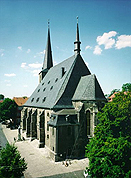 |
 Germany, WHV22 Germany, WHV22Classical Weimar
Date: 08/10 ~ 08/24
Weimar is a beautiful small city, located in the middle of Germany in the state of Thuringia. It has a huge number of cultural important places, because of the moved history. Especially the Classical Period made the city, what it is now. By the late 18th century many of the leading writers and thinkers in Germany, such as Goethe, Schiller and Herder came to Weimar and shaped the cultural life and in the same time the image of the city. Weimar became the cultural centre of Europe at that time. Even many painters, composers and philosophers lived in the city during the classical period. And still now you find many creative and inspired people living in Weimar, that were attracted by the great accumulation of cultural spirit. Since 1998 the "Classical Weimar" is on the list of UNESCO's World Heritage. Besides Goethe'sHouse, the City Church and the CityPalace especially the great parks and gardens, with their impressive landscape architecture and pretty castles are part of the UNESCO Classical Weimar ensemble. During the 20th entury Weimar became the birthplace of the Modern Movement in architecture and aesthetics. The Bauhaus was developed by merging the Grand Ducal School of Arts and Crafts and the Weimar Academy of Fine Arts. The founder of the school was Walter Gropius. Other important teachers of the Bauhaus were Johannes Itten, Lyonel Feininger and Wassily Kandinsky. The Bauhaus had, and still has, a profound influence upon developments in art, architecture, design and typography. The "Bauhaus and its Sites in Weimar and Dessau" is also listed as UNESCO World Heritage. For all this historical important marks and to spread the knowledge of the past, Weimar became European Capital of Culture in 1999.
Work : The project wil consist of two parts .a practical workingpart and a study part . In the first half of the days the practical working part will take place and in the afternoons and evenings there will be time for the study activities. Concerning the working part, the volunteers will do gardening and parksofthe ClasicalW ceaimrearin the diferent . They will work seven hours a day, five days a week.
Location : Thuringia (Close cities: Erfurt (20 km), Jena (20 km))
Accomodation : Shared 8- or 6- bed-room in a hostel in the city
|

|
 Italy, WHV23 Italy, WHV23Historic Centre of Naples
Date: 06/13 ~ 06/27
From the Neapolis founded by Greek settlers in 470 B.C. to the city of today, Naples has retained the imprint of the successive cultures that emerged in Europe and the Mediterranean basin. This makes it a unique site, with a wealth of outstanding monuments such as the Church of Santa Chiara and the Castel Nuovo.
The project is organized by cultural association VEDI NAPOLI in collaboration with Opera Don Calabria, an association with catholic background which takes care of disadvantaged and street children from more than 40 years. Situated in the centre of Naples, Opera Don Calabria is actively involved in the organisation of social and cultural activities for the young people of the area such as vocational trainings, scholar support, sport initiatives, artistic workshops etc. The aim is to facilitate the social integration of marginalized people in the city. This workcamp is part of World Heritage Volunteers campaign of UNESCO. The historical centre of Naples is one of the most important in Europe inscribed in the World Heritage list of UNESCO since 1995. It has a huge cultural background which needs to be preserved and valued. Modern life in Naples doesn't help the preservation of its treasures. Promotional and volunteering activities are part of the solution in helping preserving the cultural elements of the site. Moreover, volunteering in that area will contribute in making the locals aware of their heritage and of the difficult situation it is going through.
Work : In the morning volunteers will take part in manual/environmental activities as cleaning Bellini square in the historical centre of Naples and taking care of green areas around. They will also take part in workshops and organize activities on "World Heritage" concept and international volunteering as a tool for intercultural dialogue diffusion. In the afternoon they will help the organisation of a small football tournament, organized by Opera Don Calabria centre. The international volunteers will support the local volunteers in the implementation of the activities linked to the tournament and clean up the site. The volunteers will be working 6 hours per day, 5 days a week.
Location : Piazza Bellini, Naples
Accomodation : Volunteers will live in the centre managed by Opera Don Calabria (15 min walking to piazza Bellini). The association has a catholic background. The living conditions are basic, please bring a sleeping bag and a mat as there is no camp beds. The centre is equipped with showers and a small kitchen so volunteers will clean and cook as a group.
|

|
 Italy, WHV24 Italy, WHV24Archeological Area of Herculaneum
Date: 06/29 ~ 07/13
When Vesuvius erupted on 24 August AD 79, it engulfed the two flourishing Roman towns of Pompei and Herculaneum, as well as the many wealthy villas in the area. These have been progressively excavated and made accessible to the public since the mid-18th century. The vast expanse of the commercial town of Pompei contrasts with the smaller but better - preserved remains of the holiday resort of Herculaneum, while the superb wall paintings of the Villa Oplontis at Torre Annunziata give a vivid impression of the opulent lifestyle enjoyed by the wealthier citizens of the Early Roman Empire.
Work : The project aims to raise awareness about Ercolano, one of the richest archeological areas of Campania region, among the local community and tourists from all over the world, as well as to improve the welcome area close to the old ruins, for better site management.
The volunteers will participate in both manual and promotional activities at the site such as: collecting garbage; cleaning gardens at the entrance; welcoming visitors as guides to the site; preparing and running daily workshops about the archaeological site. As final events, the volunteers will organize a flash mob or/and a theatre performance about new approaches to site management, a documentary about the workcamp experience and a photo exhibition.
Partners: The project is supported by the Youth Forum of Ercolano, Municipality of Ercolano, Municipality of San Giorgio a Cremano, Youth Policy Office of San Giorgio a Cremano, The Herculaneum Centre, Pro Loco Hercvlanevm.
|

|
 Russia, WHV25 Russia, WHV25Historic Centre of Saint Petersburg and Related Groups of Monuments
Date: 07/01 ~ 07/15
The 'Venice of the North', with its numerous canals and more than 400 bridges, is the result of a vast urban project begun in 1703 under Peter the Great. Later known as Leningrad (in the former USSR), the city is closely associated with the October Revolution. Its architectural heritage reconciles the very different Baroque and pure neoclassical styles, as can be seen in the Admiralty, the Winter Palace, the Marble Palace and the Hermitage.
Work :
The volunteers will be engaged in improving the parks: take care of plantation of trees, mow the meadows, cure the trees, clean the hollows, sweep the grounds, cleaning them out of the garbage etc. It's Possible, that Volunteers will be involved in the preparation for the anniversary of 400 years of the the Russian Imperial House-the Romanoff Dynasty (1613-2013) (http://www.imperialhouse.ru/eng/).
Terminal : Pulkovo International Airport is located about 17 km from the St-Petersburg center
Accommodation : In St-Petersburg
|
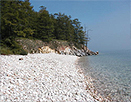
|
 Russia, WHV26 Russia, WHV26Lake Baikal
Date: 07/18 ~ 07/31
Lake Baikal is situated in south-east Siberia, it is the deepest lake in the world (1,637 m), contains 20% of all fresh running water on the planet, making it the single largest reservoir. The lake contains an outstanding variety of endemic flora and fauna, of exceptional value to evolutionary science. Lake Baikal is included in the World Heritage list of UNESCO. It`s very popular tourist area where now big problem with garbage exists.
The project is organized by Baikal State Nature Biosphere Reserve. The mission of the Reserve is preservation of natural systems of southern part of Lake Baikal. The main task is to promote ideas of peace and respect for nature among young people all over the world through international volunteer activity. This camp will help to promote and develop these ideas and involve more people in the movement of environmental protection of Lake Baikal and nearest territories.
Work :
- collecting, sorting (plastic, glass, paper, aluminum) and preparation garbage for transportation from the territory of the Lake Baikal coast,
- organizing of various forms of environmental education of local people to inform local people and tourists about importance, unique and ecological problems of Lake Baikal and nearest territories like PR-campaigns and exhibition "Second life of garbage",
- Throughout the year, the Reserve provides biotech work to maintain wild ungulates (deer, roe deer) during the winter. In this context, in July 2013 it is planned to procure the fodder to feed ungulates in snowy winter time. Volunteers will prepare
birch brooms and other plants.
Location : Tanhoi settlement
Terminal : Ulan-Ude or Irkutsk
Accommodation : Volunteers will leave in tents for 3-6 persons not far from the working place. Toilets and showers will be provided in special place. Also volunteers will have the opportunity to try Russian banya. Volunteers will prepare food by themselves in special organized place. Be ready that living conditions will be very simple.
|
|
|
|
|



